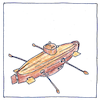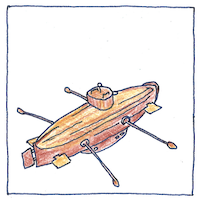Cornelis Drebbel
mechanics

|
Submarine
If not an actual leather-clad submarine propelled by oars and able to carry sixteen, including King James, underwater in the Thames from Westminster to Greenwich then the Drebbel was at least a demonstration of the idea of a submarine— reported at the time to be like putting Jonah in the belly of the whale.
Submarine principles
The first difficulty of a practical submarine was how to sink below the waves when the water it displaces lifts it up. The second difficulty was how to maintain, underwater, air fit to breathe for an extended time. For this, Drebbel had distilled the essence of air and put it in a bottle that he unstopped when needed. The third difficulty was how to propel the craft and how to navigate without being able to see the stars. The first submarines relied on human power, using oars, or cranks to turn a propeller. Oxygen supply and exhaust complicated the use of combustion engines. The first electrically powered boats became feasible in the 1880s. Johannes Gutenberg had sold a periscope for people to see over the heads of a crowd, and Johannes Hevelius described the first periscope with lenses. In 1866, the Sub Marine Explorer used ballast tanks and pressurized the cabin air to equal the pressure of water to harvest pearl oysters through open hatches at the bottom, but after returning to the surface its inventor and crew died from decompression sickness.
Another element
If such a thing were possible— to travel comfortably and unseen underwater— it would be like walking through walls, like having a cloak of invisibility, like descending through mountains, flying through water as a bird flies through the air.



Cornelis Drebbel realized that the submarine could enable stealth warfare at sea. Undetected underwater, a submarine could use a battering ram to sink ships at harbor.
See also in The book of science:
Readings in wikipedia:
Other readings: